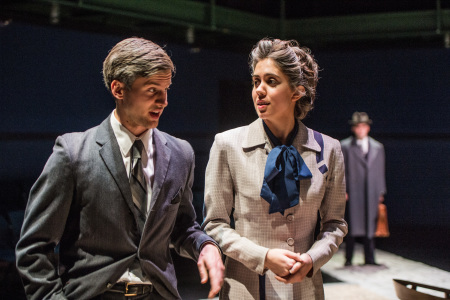
In Michael Frayn’s “Copenhagen” characters orbit in and out of each other’s lives, colliding like the atomic particles they study as personal, political and scientific tensions play out onstage.
The play is directed by Professor Ellen Mease, Theatre and Dance, and dramatizes the relationship between the famed scientists Werner Heisenberg and Niels Bohr as World War II pits the one-time friends against each other. The science they study becomes fraught with national loyalties as the possibility of atomic bombs looms ever larger.
The action onstage consists of a series of hypothetical remembrances of the past, as Bohr and Heisenberg re-enact their wartime meetings in an attempt to solve the mystery of what really occurred during the crucial years of the war and who was to blame for the suffering that ensued in the wake of the atomic bomb’s creation.
To Mease, “Copenhagen” remains a remarkably relevant play.
“It’s a perfect play for an academic setting, especially a liberal arts undergraduate setting … [it’s] a very smart play about a scientific phenomena that of course affects all of us now and will continue to affect us,” Mease said. “Atomic energy, atomic weapons. It couldn’t be more timely.”
The play features a cast of only three characters: the physicist Niels Bohr (played by Ian Saderholm ’15), his wife Margretha Bohr (played by Scout Slava-Ross ’17) and his one-time apprentice Werner Heisenberg (played by Matt Steege ’17). Mease said that this intimately-sized cast enables the play to explore the deep and complex nexus of relationships the characters share.
“There’s a kind of Proustian remembrance of things past when they are able to actually recapture their relationship without any of the burden of guilt or the terrible tangle of miscommunication and misconception and misunderstanding that marred their relationship later on,” Mease said. “It’s the pleasure of figuring out the cunning, the deep intelligence as well as the depth of feelings in the script that a small cast allows.”

The play revolves around the atomic properties Bohr and Heisenberg explored writ large on a circular set in Flanagan Studio Theatre. Science becomes indistinguishable from human drama as mysterious parallels emerge between the atomic structure and the unknown motivations of the characters onstage. “We lived inside the atom,” Heisenberg recalls in one scene, and his words ring true for the actors onstage as well as the characters they portray. Mease said that the atomic model emerges as the metaphor which the play’s action is structured around.
“The interior of the atom poses such interesting problems, because you can’t see what’s going on,” Mease said. “It takes the human act of observation and efforts of the human imagination which try to determine what it is that’s going on—and even that is only an approximation. So the relationship between the observer and the thing observed, the scientist and the natural world, that he or she hopes to be able to describe in a determinate and objective way proves as elusive as it is to know what’s going on inside the human head and the human heart.”
“Copenhagen” offers an attempt to flesh out the historical record of Bohr and Heisenberg’s friendship by imagining the myriad possible motivations behind their work on atomic research and weaponization. Saderholm said that these ambiguous motivations are conveyed by revisiting the same scenes multiple times over the course of the play.
“The whole play revolves around this one kernel, this one event, that they don’t know what happened,” Saderholm said. “We go back and flesh it out … but the motivations behind it are always up in the air, ’cause those are the ethereal things, the things that you can’t pin down concretely.”
Steege believes that the play confronts its audience with universal ethical dilemmas that ensure its enduring relevance.
“I think the play discusses the human capacity for both great good and great evil and great accident,” Steege said. “I think everybody on some level has that fear of ‘What could I do, if I were put in that right situation, and if I were put in an impossible situation?’ When the unstoppable force meets the immovable object, what budges? Because it’s easy to look at something and say ‘never again’ … I think it’s a much harder and much rarer thing to look at the inception of something and say ‘never begin.’”

Performances of “Copenhagen” will take place in Flanagan Studio Theatre in Bucksbaum tonight at 7:30 p.m., Saturday, Nov. 22 at 7:30 p.m. and Sunday Nov. 23 at 2 p.m. Tickets are free and are available through the Bucksbaum box office or by calling 269-4444.

























































Crosby • Nov 21, 2014 at 12:43 pm
I especially liked the play after the intermission.